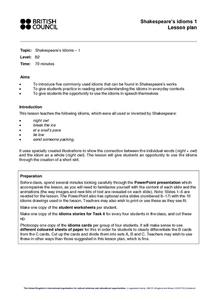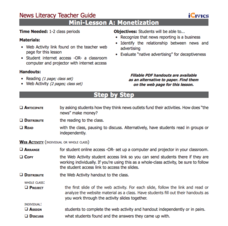Read Works
The Boy Who Cried Wolf
Reinforce reading comprehension strategies and contemplate an important life lesson with a worksheet featuring Aesop's fable, The Boy Who Cried Wolf. After reading a brief passage, scholars show what they know by way of...
British Council
Macbeth
Double the fun of studying Shakespeare with an interactive that introduces English learners to Macbeth. After watching a short, animated video that presents key elements of the plot, class members complete a worksheet identifying the...
British Council
William Shakespeare
After watching a three-minute video detailing the life of William Shakespeare, scholars take part in several activities designed to show what they know about the famous writer. Learners read a series of eight sentences and put them in...
New York City Department of Education
Grade 5 Literacy: TCRWP Nonfiction Reading and Opinion/Argument Writing
Choose a side! Pupils watch and read several nonfiction resources about zoos. After gathering their research, they choose a side either for or against closing zoos. Scholars complete KWL charts, anticipation guides, flow charts, and...
K12 Reader
5th Grade Master Spelling List
Here's a spelling program that includes 36 lists of 21 words and 20 suggestions for weekly activities. Each list includes common and proper nouns, sight words, academic vocabulary, and words built on a specific Greek roots.
Scholastic
Make Your Own Fly Guy Comic
Is your class reading Hi! Fly Guy by Tedd Arnold? Get them involved in the story-creation process with this partially blank comic strip template. Learners take a look at the first and last panels and then fill in the remaining four with...
British Council
Shakespeare’s Idioms
Lie low. Break the ice. He's a night owl. Idioms, in this case idioms created by Shakespeare, are the focus of resource that includes a PowerPoint presentation, an activity, and a brief lesson, all intended to give kids a chance to...
Reproducible Master
Reader’s Journal
As you read a story or novel, have your class members put together and fill out a journal. They will have the chance to illustrate a cover page, draw and write about various topics, respond to a focus questions, and draft a paragraph.
iCivics
Lesson 1: Journalism
Extra! Extra! Do your pupils know what it takes to be a good journalist? Young news hounds explore the world of journalism through a series of activities that focus on ethical reporting. Learners read, evaluate, and investigate popular...
iCivics
Mini Lesson A: Monetization
Advertising is everywhere! Does your class know that their attention span is for sale, even when they're watching a simple news story? The second installment in a five-part series from iCivics examines the relationship between news...
iCivics
Lesson 2: Misinformation
Fake news is a hot topic right now ... but what is it? Intrepid young investigators track down the facts that separate journalistic mistakes and misinformation through reading, research, and discussion. Part three in a five-lesson series...
iCivics
Lesson 3: Bias
How do journalists balance bias and ethical reporting? The final instructional activity in a series of five from iCivics examines the different types of bias and how they affect the news we read. Young reporters take to the Internet to...
Roald Dahl
The Twits - The Twits Get the Shrinks
Turn readers into investigative journalists. The 11th and final lesson that accompanies The Twits by Roald Dahl asks the question "What happened to Mr. and Mrs. Twit?" The lesson uses mind maps and group discussion to help answer...
Curated OER
Voter Fraud: Are Ghosts Going To The Polls
Learners research background material about voting in their community. They interview local/county election officials to see what is going on in the community. They also interview teachers, and students to determine if they are newly...
Curated OER
Writing Skills: Statistical Report
A simple text analysis lesson, language learners transfer, order, and group information so that it is presentable. No apparent link to the five required worksheets.
Curated OER
A Garden of Verses: Poems About Class Gardens
Students explore botany by participating in a language arts activity. In this garden poetry lesson, students read the classic poem "Mary, Mary Quite Contrary" and discuss the imagery and rhyming methods used. Students examine their own...
Savvas Learning
Let's Get Moving
Scholars examine, cut, paste, and sort 12 images featuring different types of movement in order to show what they know about energy—potential and kinetic.
Curated OER
Silver Blaze and Other Stories
In this Silver Blaze and Other Stories reading and study guide worksheet, students respond to 8 multi-step short answer, multiple choice, and graphic organizer questions. The questions are designed to be answered before, while, and after...
Curated OER
Troublesome Word Rap
Create songs and raps to develop an understanding of the proper use of common misused words and homophones. First, your class defines misused words and homophones correctly by utilizing the words in a rap or song. Then they use...
Curated OER
Shining The Love on Reading!
Students enjoy reading independently. In this independent reading concept, students are given a finger flashlight to make silently reading a book at their instructional level more enjoyable.
Curated OER
Bad Case of the Stripes Lesson Plan
Young scholars listen to the story Bad Case of the Stripes. In this respect lesson, students listen to the story and discuss bullying and how to respect others. They draw a picture of themselves covered in what they like to do.
EduBlogger
Vocabulary Squares
As part of their vocabulary study, readers select unfamiliar words from their current reading assignment, record the etymology and part of speech, variations, the definition, and draw a symbol, logo, or icon. They then create a sentence...
Macmillan Education
Understanding Poetry
William Wordsworth's "Daffodils" provides young poets with an opportunity to examine how a poet can use powerful images and poetic devices to create vivid pictures in the minds of readers.
Curated OER
BrainStorming
Students, through modeling and independent practice, are introduced to the different methods of brainstorming. They explore and engage in these different approaches individually, in pairs, and as a group.























